Data-Driven Deformation Prediction of Accumulation Landslides in the Middle Qinling-Bashan Mountains Area
Abstract
:1. Introduction
2. Methods
2.1. Classification of Landslides Method
2.2. Model Construction Method
- Forget gate
- Input gate
- Output gate
2.3. Selection of Evaluation Indicators
3. Research Case
4. Comparative Experiments on Group Prediction
4.1. Experimental Process
4.2. Key Feature Selection
4.3. Analysis of Results and Discussion
5. Discussion
6. Conclusions
- The displacement prediction model for similar-type landslides performs better in displacement prediction than the mixed-type landslide prediction model.
- The displacement prediction models for similar-type landslides and individual slope landslides tend to converge in performance. For predicting displacement in the next 12 h, the similar-type landslide model outperforms the individual slope model. The effectiveness of longer-duration predictions is closely related to the developmental stage of the predicted landslide.
- The similar-type landslide displacement prediction model can learn the sliding characteristics of landslides at different evolutionary stages, providing a scientific basis for early prediction and warning of landslides. It effectively addresses the issues of insufficient early monitoring data and low prediction accuracy in landslide monitoring.
Author Contributions
Funding
Data Availability Statement
Acknowledgments
Conflicts of Interest
References
- Fan, L.M.; He, J.J.; Li, C.G. Study on development patterns of landslide in Qinling-Bashan Mountains. Chin. J. Geol. Hazard Control. 2004, 15, 47–51. [Google Scholar]
- Sun, G.M.; Kuang, M.S.; Qu, H. Research of Geological Disaster in Qingling—Bashan Mountains. Res. Soil Water Conserv. 2005, 12, 240–243. [Google Scholar]
- Wang, C.H.; Zhao, Y.J.; Bai, L.B.; Gou, W.; Meng, Q. Landslide Displacement Prediction Method Based on GA-Elman Model. Appl. Sci. 2021, 11, 11030. [Google Scholar] [CrossRef]
- Miao, F.S.; Wu, Y.P.; Xie, Y.H.; Li, Y.N. Prediction of landslide displacement with step-like behavior based on multialgorithm optimization and a support vector regression model. Landslides 2018, 15, 475–488. [Google Scholar] [CrossRef]
- Xie, H.L.; Zhang, L.; Lim, C.P. Evolving CNN-LSTM Models for Time Series Prediction Using Enhanced Grey Wolf Optimizer. IEEE Access 2020, 8, 161519–161541. [Google Scholar] [CrossRef]
- Ma, Z.J.; Mei, G. Deep learning for geological hazards analysis: Data, models, applications, and opportunities. Earth-Sci. Rev. 2021, 223, 103858. [Google Scholar] [CrossRef]
- Lian, C.; Zeng, Z.G.; Yao, W.; Tang, H.M. Multiple neural networks switched prediction for landslide displacement. Eng. Geol. 2015, 186, 91–99. [Google Scholar] [CrossRef]
- Yin, S.D.; Feng, X.T.; Zhou, H.; Zhao, H.B.; Li, S.J. Study on GA-NN model for forecasting the displacement of landslides affected by rainfall. Rock Soil Mech. 2003, 24, 1038–1041. [Google Scholar]
- Wang, C.H.; Zhao, Y.J.; Bai, L.B.; Guo, W.; Meng, Q.J. Application of renewal gray GM (1,1) model to prediction of landslide deformation with two case studies. Hydrogeol. Eng. Geol. 2009, 36, 108–111. [Google Scholar]
- Deng, D.M.; Liang, Y.; Wang, L.Q.; Wang, C.S.; Zhang, Z.H.; Wang, C.; Dong, M.M. Displacement prediction method based on ensemble empirical mode decomposition and support vector machine regression—A case of landslides in Three Gorges Reservoir area. Rock Soil Mech. 2017, 38, 3660–3669. [Google Scholar]
- Liu, Y.; Liu, D.; Qin, Z.M.; Liu, F.B.; Liu, L.B. Rainfall data feature extraction and its verification in displacement prediction of Baishuihe landslide in China. Bull. Eng. Geol. Environ. 2016, 75, 897–907. [Google Scholar] [CrossRef]
- Pei, H.F.; Meng, F.H.; Zhu, H.H. Landslide displacement prediction based on a novel hybrid model and convolutional neural network considering time-varying factors. Bull. Eng. Geol. Environ. 2021, 80, 7403–7422. [Google Scholar] [CrossRef]
- Jia, W.J.; Wen, T.; Li, D.C.; Guo, W.; Quan, Z.; Wang, Y.H.; Huang, D.X.; Hu, M.Y. Landslide Displacement Prediction of Shuping Landslide Combining PSO and LSSVM Model. Water 2023, 15, 612. [Google Scholar] [CrossRef]
- Deng, L.Z.; Smith, A.; Dixon, N.; Yuan, H.Y. Machine learning prediction of landslide deformation behaviour using acoustic emission and rainfall measurements. Eng. Geol. 2021, 293, 106315. [Google Scholar] [CrossRef]
- Yang, Z.R.; Xi, W.F.; Yang, Z.Q.; Shi, Z.T.; Huang, G.C.; Guo, J.Q.; Yang, D.Q. Time-Lag Response of Landslide to Reservoir Water Level Fluctuations during the Storage Period: A Case Study of Baihetan Reservoir. Water 2023, 15, 2732. [Google Scholar] [CrossRef]
- Song, K.; Han, L.Y.; Ruan, D.; Li, H.; Ma, B.H. Stability Prediction of Rainfall-Induced Shallow Landslides: A Case Study of Mountainous Area in China. Water 2023, 15, 2938. [Google Scholar] [CrossRef]
- Li, D.Y.; Sun, Y.Q.; Yin, K.L.; Miao, F.S.; Glade, T.; Leo, C. Displacement characteristics and prediction of Baishuihe landslide in the Three Gorges Reservoir. J. Mt. Sci. 2019, 16, 2203–2214. [Google Scholar] [CrossRef]
- Wang, J.; Nie, G.G.; Xue, C.H. Landslide displacement prediction based on time series analysis and data assimilation with hydrological factors. Arab. J. Geosci. 2020, 13, 460. [Google Scholar] [CrossRef]
- Meng, Q.X.; Wang, H.L.; He, M.J.; Gu, J.J.; Qi, J.; Yang, L.L. Displacement prediction of water-induced landslides using a recurrent deep learning model. Eur. J. Environ. Civ. Eng. 2020, 27, 2460–2474. [Google Scholar] [CrossRef]
- Varnes, D.J. Slope Movement Types and Processes; Transportation Research Board Special Report; National Academy of Sciences: Washington, DC, USA, 1978. [Google Scholar]
- Liu, G.R.; Chu, Z.C.; Guo, X.Z.; Liu, Y. Summary of main achievements of study on important geological and seismological problems in sanxia gorges of changjiang river. Chin. J. Geol. Hazard Control 1992, 3, 9–16. [Google Scholar]
- Zhang, Z.Y.; Wang, S.T.; Wang, L.S.; Huang, R.Q. Principles of Engineering Geological Analysis; Geology Press: Beijing, China, 2009. [Google Scholar]
- Yan, T.Z. Hydrologic Engineering Geology and Environmental Protection; China University of Geosciences Press: Beijing, China, 1994. [Google Scholar]
- Liu, G.R.; Yan, E.C.; Lian, C. Discussion on classification of landslides. J. Eng. Geol. 2002, 10, 339–342. [Google Scholar]
- Yan, E.C.; Liu, G.R. Discussion on the essential geological model for landslide. J. Eng. Geol. 2004, 12, 21–24. [Google Scholar]
- Ma, Z.L.; Mei, G.; Piccialli, F. Machine learning for landslides prevention: A survey. Neural Comput. Appl. 2020, 33, 10881–10907. [Google Scholar] [CrossRef]
- Chen, T.; Guestrin, C. XGBoost: A Scalable Tree Boosting System. In Proceedings of the 22nd ACM SIGKDD International Conference on Knowledge Discovery and Data Mining, San Francisco, CA, USA, 13–17 August 2016. [Google Scholar]
- Zhang, K.; Zhang, K.; Cai, C.X.; Liu, W.L.; Xie, J.B. Displacement prediction of step-like landslides based on feature optimization and VMD-Bi-LSTM: A case study of the Bazimen and Baishuihe landslides in the Three Gorges, China. Bull. Eng. Geol. Environ. 2021, 80, 8481–8502. [Google Scholar] [CrossRef]
- Bengio, Y.; Simard, P.; Frasconi, P. Learning long-term dependencies with gradient descent is difficult. IEEE Trans. Neural Netw. 1994, 5, 157–166. [Google Scholar] [CrossRef] [PubMed]
- Yang, B.B.; Yin, K.L.; Lacasse, S.; Liu, Z.Q. Time series analysis and long short-term memory neural network to predict landslide displacement. Landslides 2019, 16, 677–694. [Google Scholar] [CrossRef]
- Yan, L.; Chen, C.W.; Hang, T.T.; Hu, Y.C. A stream prediction model based on attention-LSTM. Earth Sci. Inform. 2021, 14, 723–733. [Google Scholar] [CrossRef]
- Xu, J.C.; Jiang, Y.; Yang, C.B. Landslide Displacement Prediction during the Sliding Process Using XGBoost, SVR and RNNs. Appl. Sci. 2022, 12, 6056. [Google Scholar] [CrossRef]
- Hochreiter, S.; Schmidhuber, J. Long Short-Term Memory. Neural Comput. 1997, 9, 1735–1780. [Google Scholar] [CrossRef]
- Conte, E.; Pugliese, L.; Troncone, A. A Simple Method for Predicting Rainfall-Induced Shallow Landslides. J. Geotech. Geoenviron. Eng. 2022, 148, 4022079. [Google Scholar] [CrossRef]
- Shrestha, S.; Pradhan, P.; Shrestha, H. Assessment of Rainfall-Induced Shallow Landslides in Kavre District, Nepal. SCITECH Nepal 2023, 17, 84–90. [Google Scholar] [CrossRef]
- Mandal, P.; Sarkar, S. Estimation of rainfall threshold for the early warning of shallow landslides along National Highway-10 in Darjeeling Himalayas. Nat. Hazards 2021, 105, 2455–2480. [Google Scholar] [CrossRef]
- Troncone, A.; Pugliese, L.; Lamanna, G.; Conte, E. Prediction of rainfall-induced landslide movements in the presence of stabilizing piles. Eng. Geol. 2021, 288, 106143. [Google Scholar] [CrossRef]
- Huang, J.; Ju, N.P.; He, C.Y.; Xiao, Y. Establishment of early geohazard warning system using modern information technology. J. Eng. Geol. 2015, 23, 140–147. [Google Scholar]
- Zhao, W.Y.; Ma, J.; Xiao, C.Y.; Pang, X. An Comprehensive Intelligent Rainfall-Deformation Warning Method for Rainfall-Induced Landslides. Geogr. Geo-Inf. Sci. 2022, 38, 17–22. [Google Scholar]
- Xiao, T.; Zhang, L.M. Data-driven landslide forecasting: Methods, data completeness, and real-time warning. Eng. Geol. 2023, 317, 107068. [Google Scholar] [CrossRef]
- Souza, F.T.D.; Ebecken, N.F.F. A Data Mining Approach To Landslide Prediction. WIT Trans. Inf. Commun. Technol. 2004, 33, 10. [Google Scholar]
- Wang, C.H.; Guo, W.; Yang, K.; Wang, X.; Meng, Q.J. Real-Time Monitoring System of Landslide Based on LoRa Architecture. Front. Earth Sci. 2022, 10, 899509. [Google Scholar] [CrossRef]
- Lin, Q.Y.; Yang, Z.P.; Huang, J.; Deng, J.; Chen, L.; Zhang, Y.R. A Landslide Displacement Prediction Model Based on the ICEEMDAN Method and the TCN–BiLSTM Combined Neural Network. Water 2023, 15, 4247. [Google Scholar] [CrossRef]
- Zhang, Y.G.; Tang, J.; Cheng, Y.; Huang, L.; Guo, F.; Yin, X.J.; Li, N. Prediction of landslide displacement with dynamic features using intelligent approaches. Int. J. Min. Sci. Technol. 2022, 32, 539–549. [Google Scholar] [CrossRef]
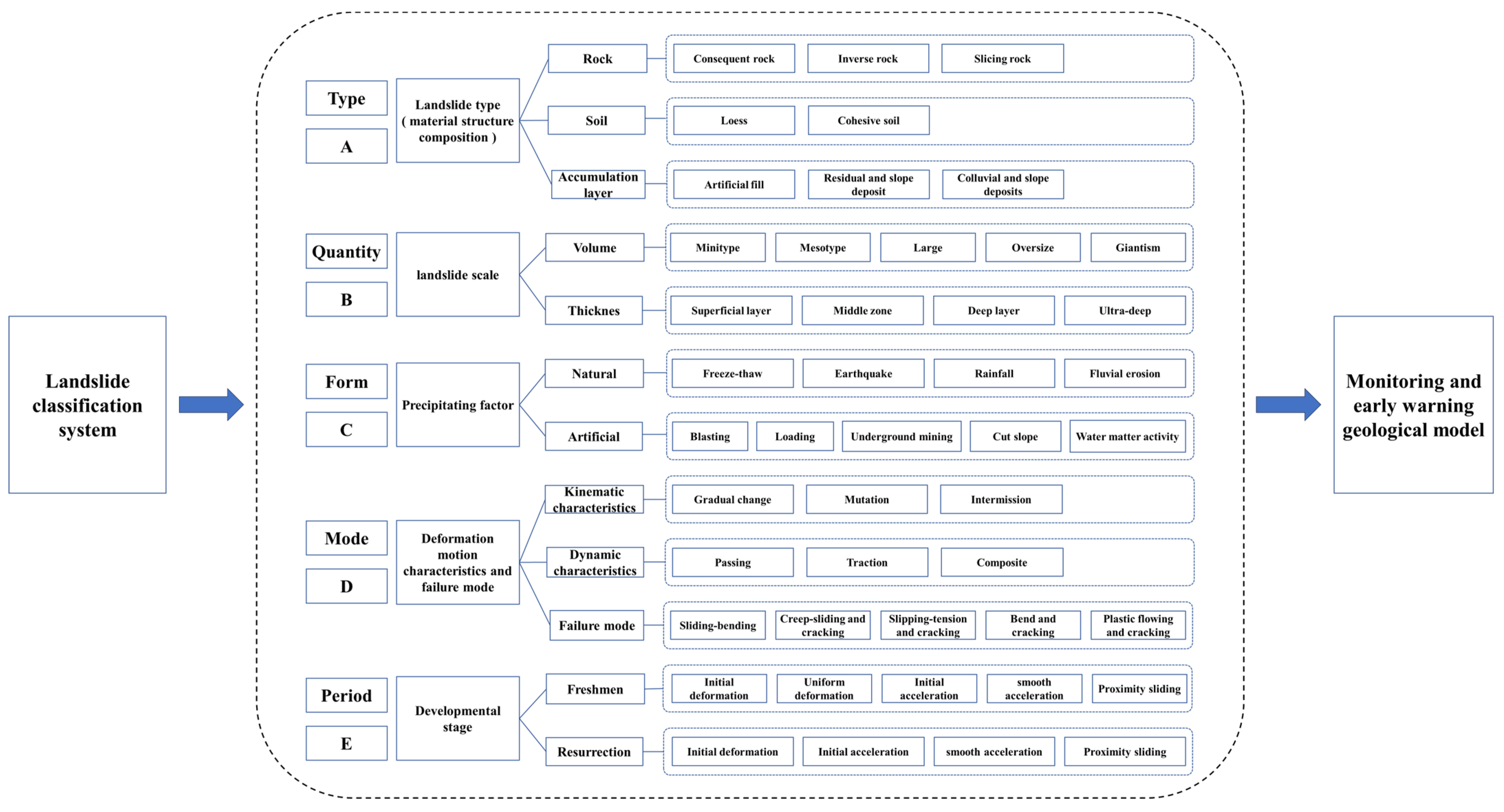
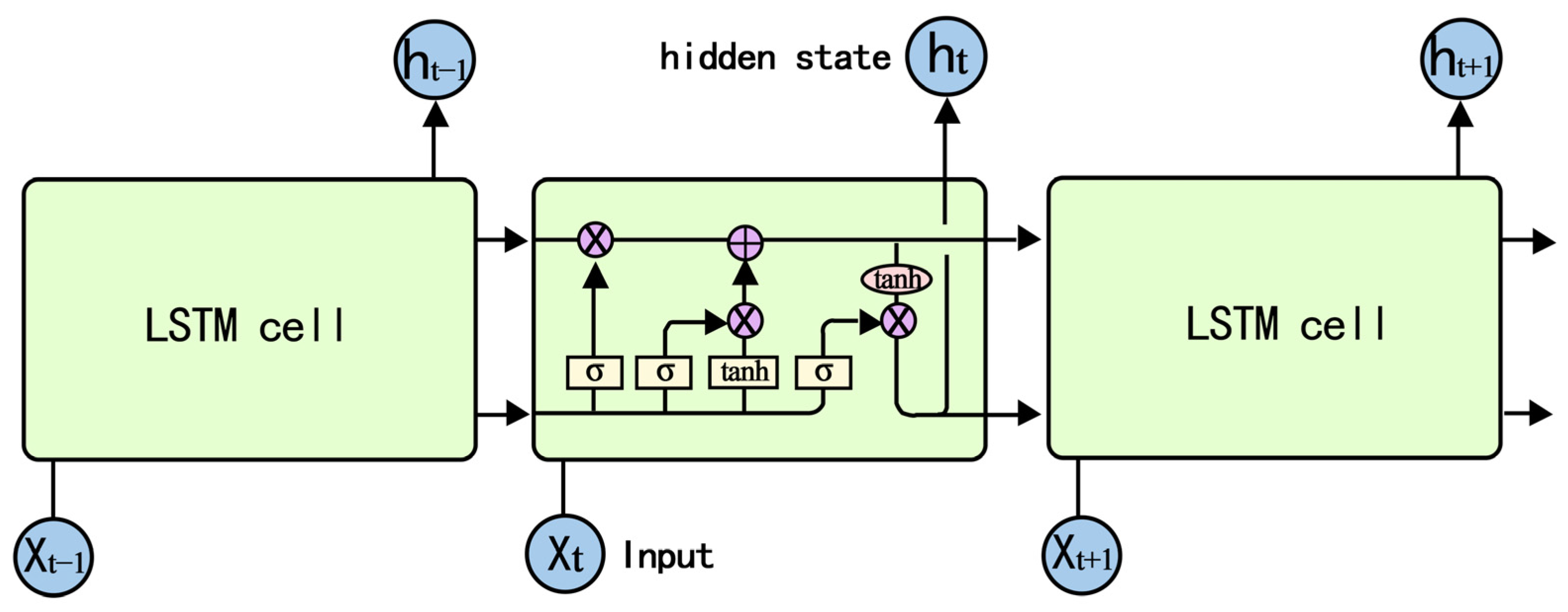
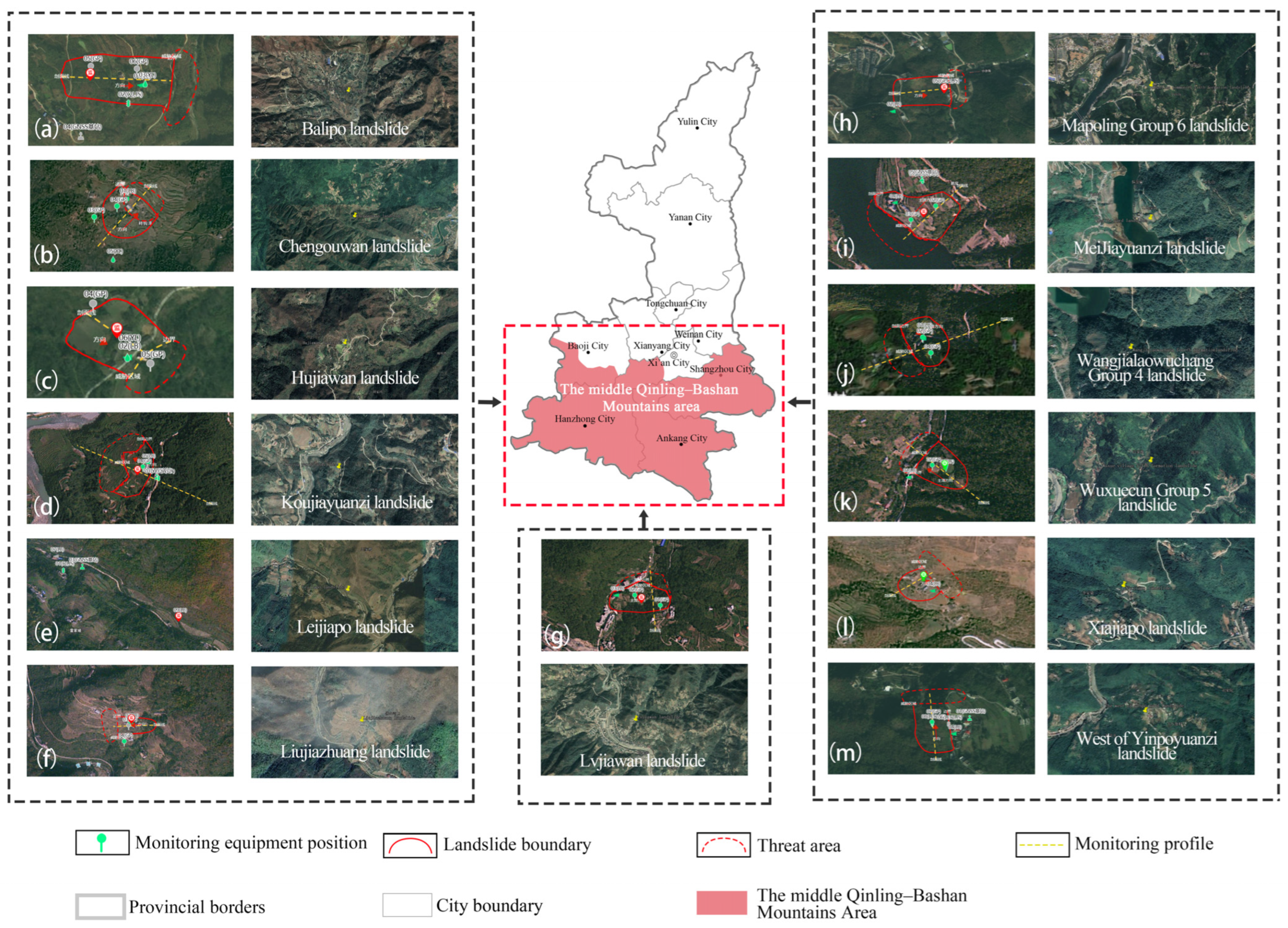
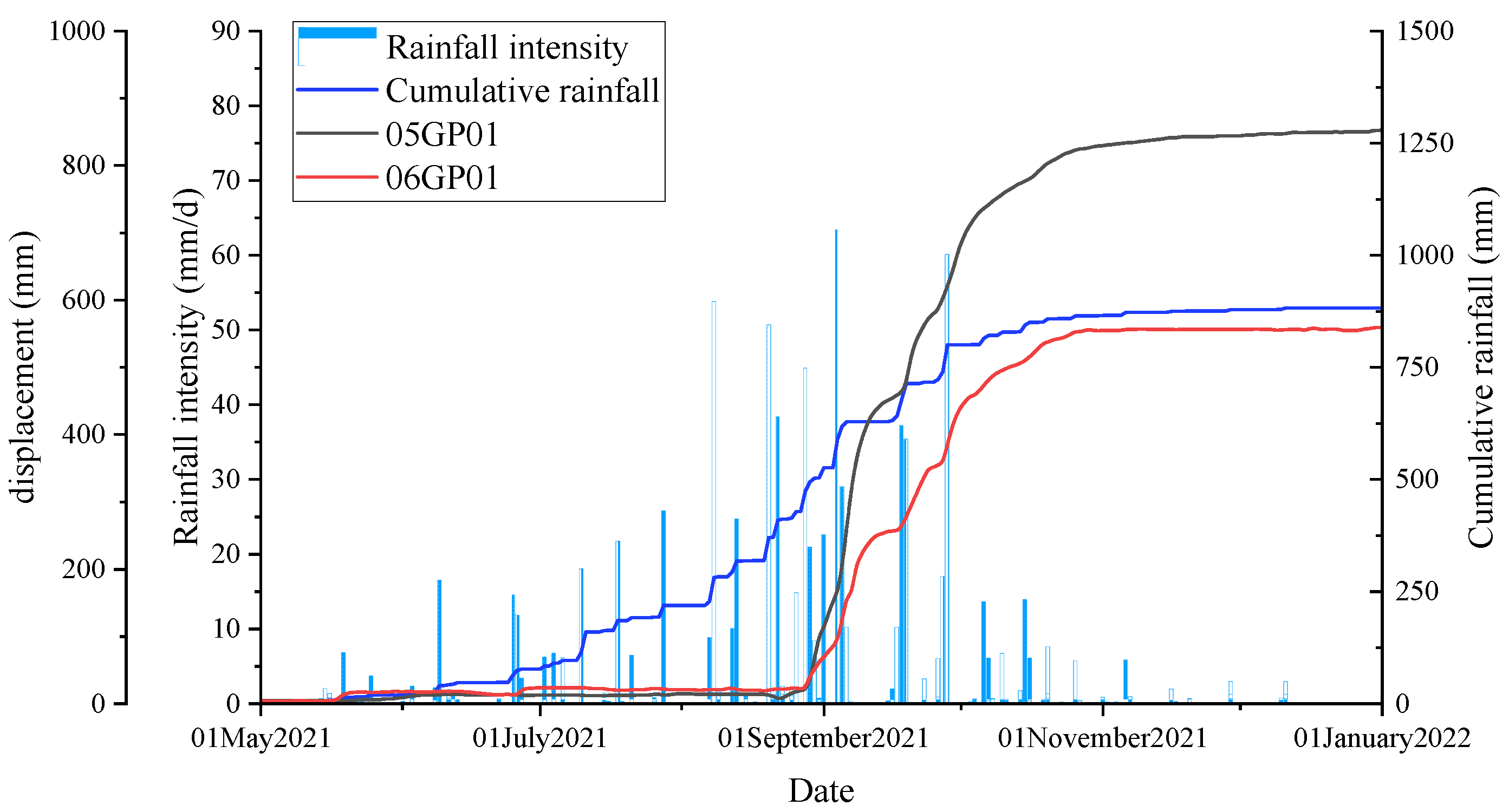
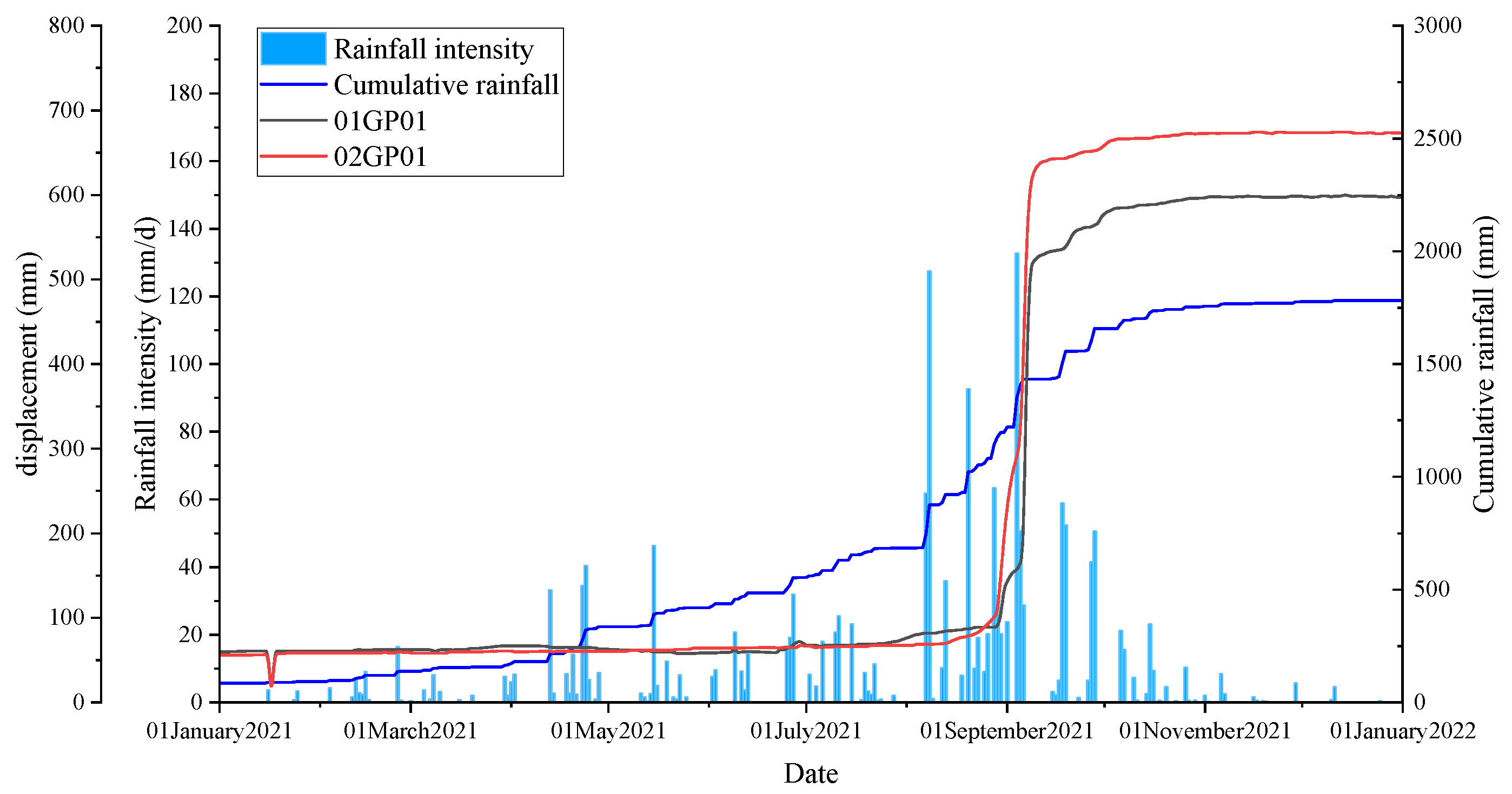
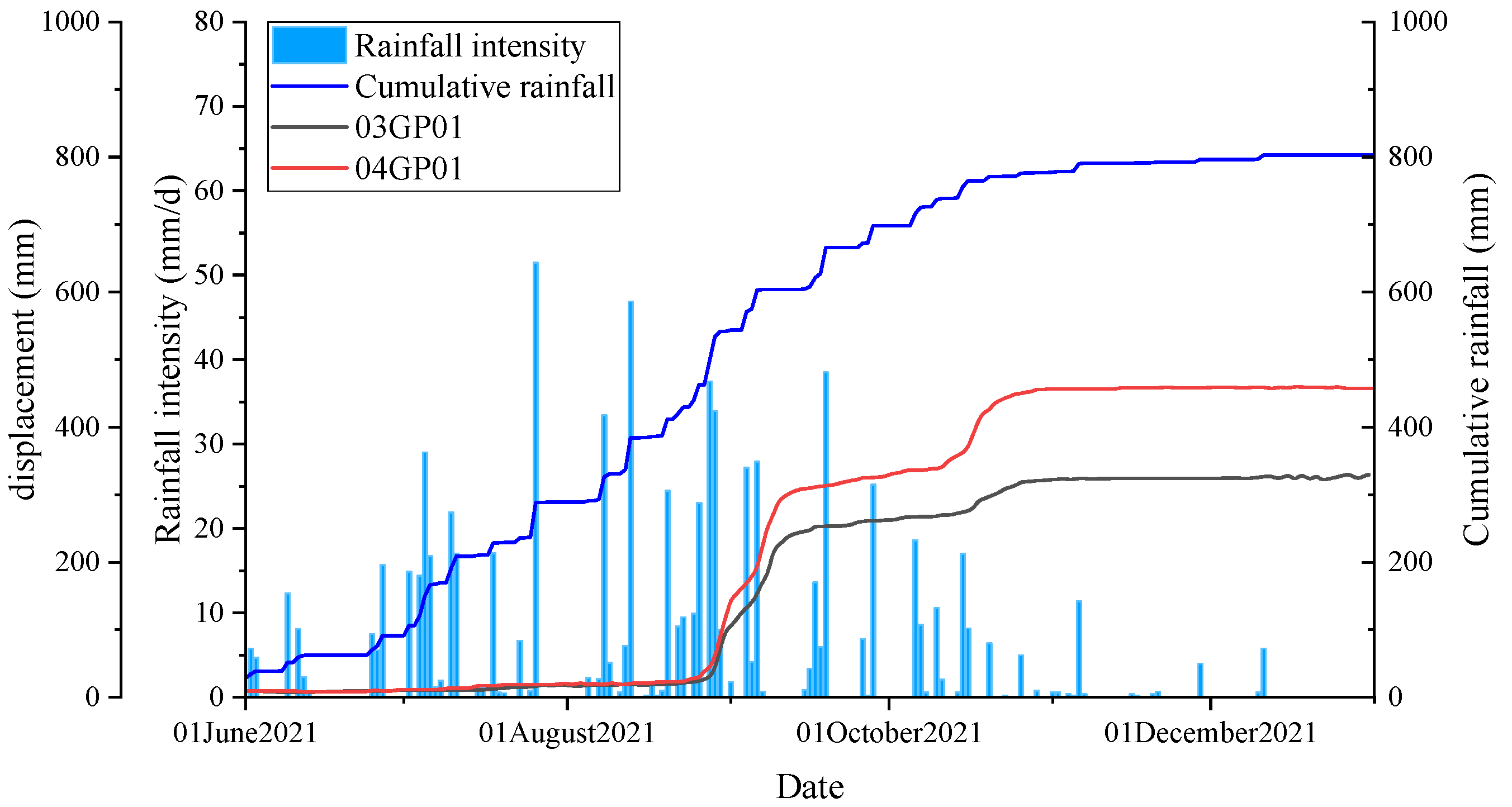
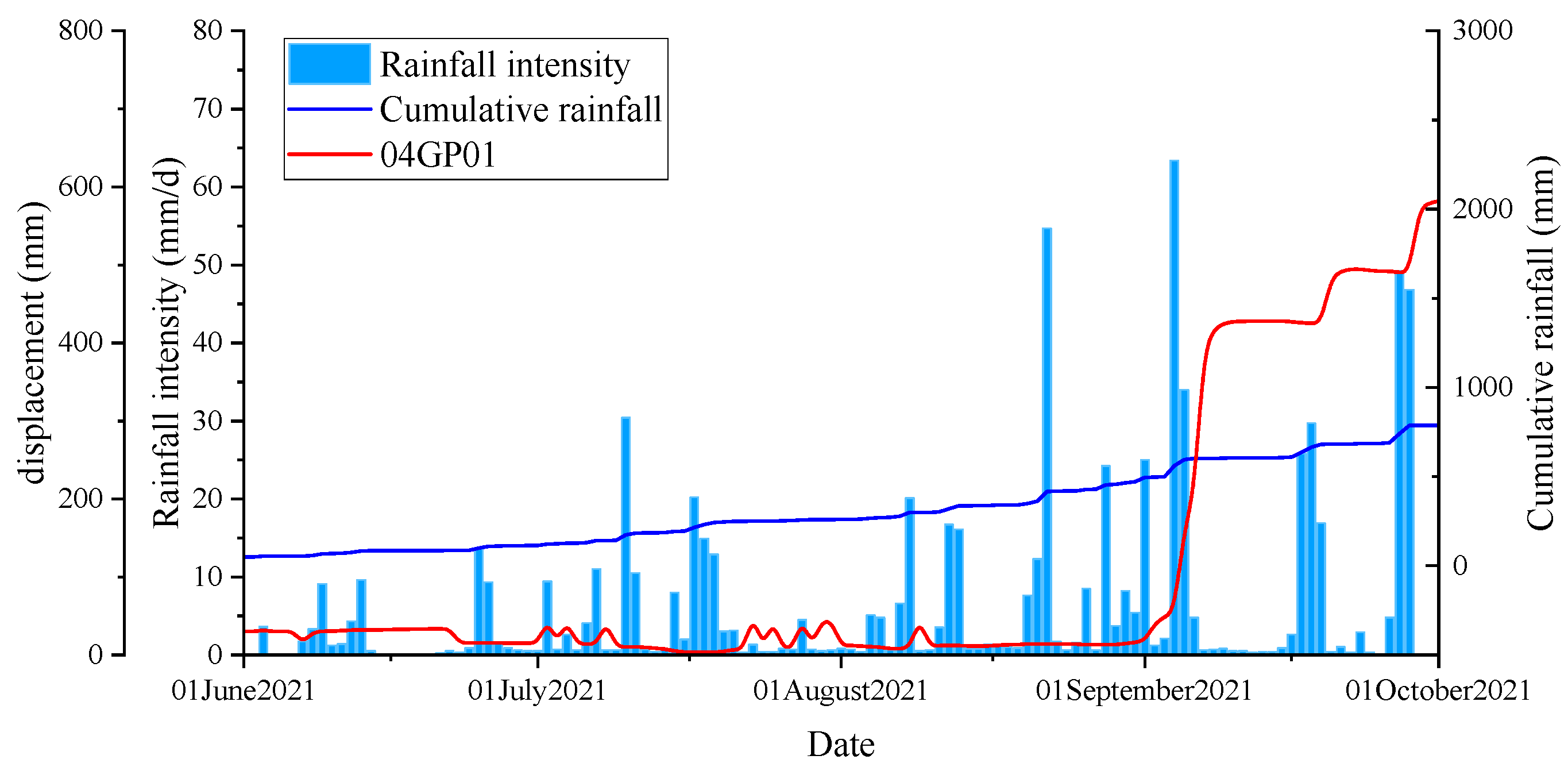


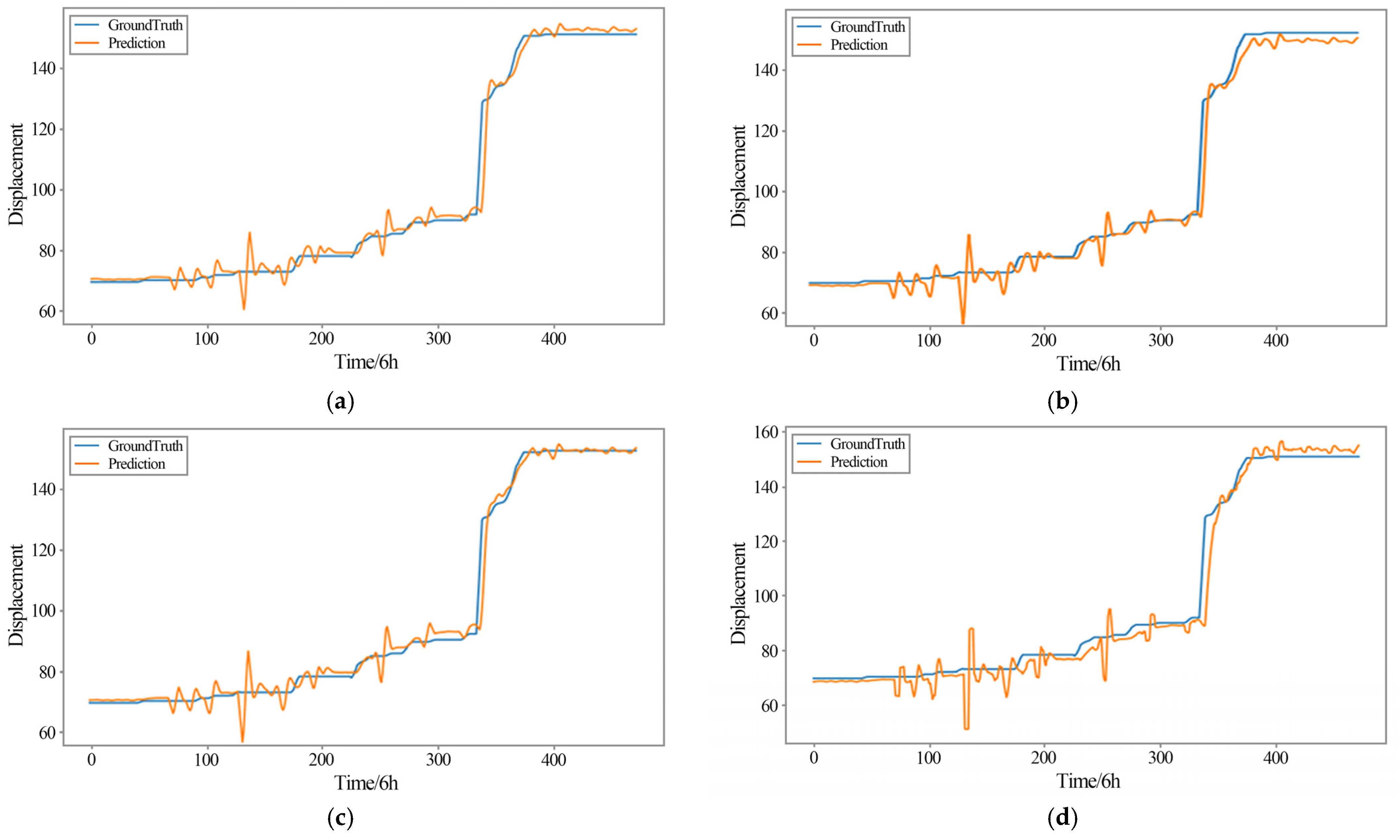

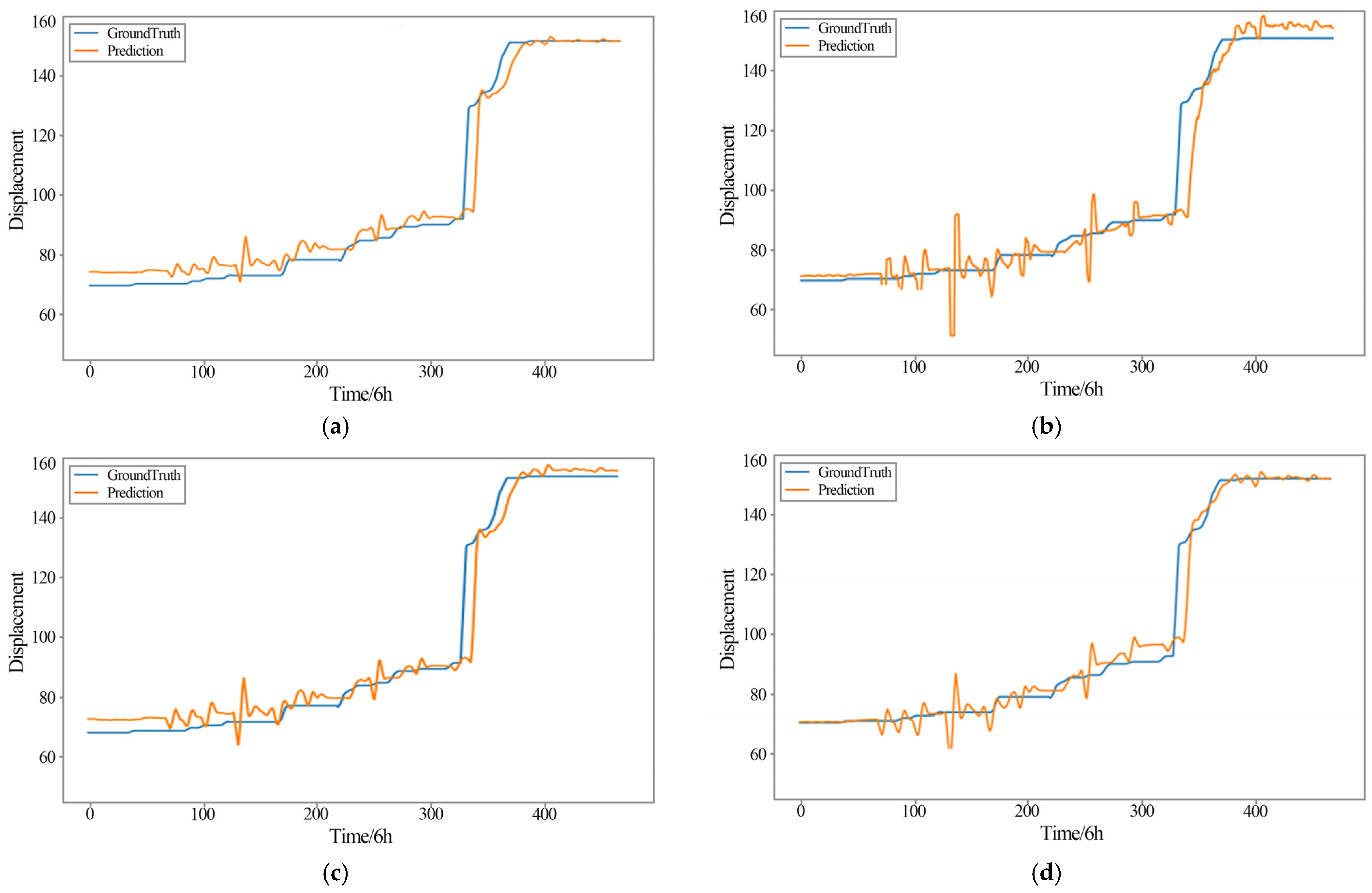
| State of Affairs | Schematic Diagram of the Evolution of the Pattern of Disasters | Characterization |
|---|---|---|
| Natural state | 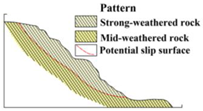 | The original slope is in its natural state, with the surface of the slope exposed, and the strongly weathered and moderately weathered surfaces of the slope are potential sliding surfaces. |
| Accelerated weathering | 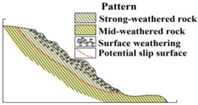 | Accelerated weathering of slopes from surface to depth |
| Stress concentration | 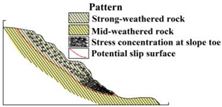 | Concentration of stresses at the foot of slopes and gradual decrease in stability |
| Landslide formation |  | Sliding surface penetrates, slide falls, landslide forms. |
| Name of the Landslide | Structural Composition of Matter | Landslide Size (Large, Medium, Small) | Predisposing Factors (Kinetic Causes) | Kinematic Characteristics (Gradual, Abrupt, Intermittent) | Kinetic Characterization (Traction, Nudge, Composite) | Developmental Stages (New, Resurrection) |
|---|---|---|---|---|---|---|
| Balipo landslide | Remnant slope product | Medium-sized | Rainfall | Abrupt | Traction | New |
| Chengouwan landslide | Landslide | Minor works | Rainfall | Abrupt | Traction | New |
| Hujiawan landslide | Slope failure | Minor works | Rainfall | Abrupt | Nudge | Resurrection |
| Koujiayuanzi landslide | Remnant slope product | Medium-sized | Rainfall | Abrupt | Traction | Resurrection |
| Lei Jiapo landslide | Slope failure | Minor works | Rainfall | Abrupt | Traction | Resurrection |
| Liujiazhuang landslide | Remnant slope product | Minor works | Rainfall | Abrupt | Nudge | New |
| Lvjiawan landslide | Landslide | Medium-sized | Rainfall | Abrupt | Nudge | Resurrection |
| Mapoling Group 6 landslide | Remnant slope product | Medium-sized | Rainfall | Abrupt | Traction | New |
| Meijiayuanzi landslide | Landslide | Medium-sized | Rainfall | Abrupt | Traction | Resurrection |
| Wangjialaowuchang Group 4 landslide | Landslide | Medium-sized | Rainfall | Abrupt | Nudge | Resurrection |
| Wuxuecun Group 5 landslide | Landslide | Minor works | Rainfall | Abrupt | Traction | Resurrection |
| Xiajiapo landslide | Landslide | Minor works | Rainfall | Abrupt | Traction | Resurrection |
| West of Yinpo Yuanzi landslide | Landslide | Minor works | Rainfall | Abrupt | Traction | Resurrection |
| Classification Code | Type of Landslide | Name of the Landslide |
|---|---|---|
| 1 | Emerging traction residual landslides | Balipo landslide, Mapoling Group 6 landslide |
| 2 | Emerging traction avalanche landslides | Chengouwan landslide |
| 3 | Emergent nudge-type residual landslides | Liujiazhuang landslide |
| 4 | Resurrection of a nudging avalanche-accumulated landslide | Hujiawan landslide, Wangjialaowuchang Group 4 landslide |
| 5 | Resurrection of a nudging debris slide | Lvjiawan landslide |
| 6 | Resurrection of traction residual landslides | Koujiayuanzi landslide |
| 7 | Resurrection of a traction avalanche landslide | Leijapo landslide, Meijiayuanzi landslide, Wuxuecun Group 5 landslide, Xiajiapo landslide, West of Yinpo Yuanzi landslide |
| Experiments | Prediction of Similar Landslides | Mixed Category Landslide Prediction | ||
|---|---|---|---|---|
| Name of the Landslide | Classification Code | Name of the Landslide | Classification Code | |
| Training set | Leijiapo landslide | 7 | Ba Lipo landslide | 1 |
| Meijiayuanzi landslide | 7 | Chengouwan landslide | 2 | |
| Wuxuecun Group 5 landslide | 7 | Liujiazhuang landslide | 3 | |
| Xiajiapo landslide | 7 | Hujiawan landslide | 4 | |
| Prediction set | West of Yinpoyuanzi landslide | 7 | West of Yinpoyuanzi landslide | 7 |
| Experiments | Prediction of Similar Landslides | Single-Slope Landslide Prediction | ||
|---|---|---|---|---|
| Name of the Landslide | Classification Code | Name of the Landslide | Classification Code | |
| Training set | Leijiapo landslide | 7 | West of Yinpoyuanzi landslide | 7 |
| MeiJiayuanzi landslide | 7 | |||
| Wuxuecun Group 5 landslide | 7 | |||
| Xiajiapo landslide | 7 | |||
| West of Yinpoyuanzi landslide | 7 | |||
| Prediction set | West of Yinpoyuanzi landslide | 7 | West of Yinpoyuanzi landslide | 7 |
| Data Item Name | Data Type | Note |
|---|---|---|
| Timing | Timestamp | Sampling frequency in hours |
| R | Continuous data | Rainfall for the day |
| R1 | Continuous data | Rainfall for the previous 1 day |
| R2 | Continuous data | Rainfall for the first 2 days |
| R3 | Continuous data | Rainfall for the first 3 days |
| Volume | String class data | Small, medium, large |
| Thicknesses | String class data | Shallow, medium, deep |
| Structural of matter | String class data | Slope failure, slope remnants |
| Elevation | String class data | Class I (slope ≤ 15°), Class II (15° ≤ slope ≤ 30°), Class III (35° ≤ slope ≤ 60°), Class IV (slope ≥ 60°) |
| Kinetic characteristics | String class data | Towed, pushed |
| Developmental stage | String class data | New, resurrection |
| Fissures | Discrete ordered data | No, yes |
| Group I Homogeneous Slopes | MSE | MAPE | A Set of Mixed Slopes | MSE | MAPE |
|---|---|---|---|---|---|
| Next 12 h | 5.036 | 0.010 | Next 12 h | 7.616 | 0.024 |
| Next 24 h | 7.333 | 0.0142 | The next 24 h | 11.085 | 0.027 |
| Next 48 h | 15.232 | 0.022 | The next 48 h | 20.670 | 0.033 |
| Group II Homogeneous Slopes | MSE | MAPE | Group II Single Slope | MSE | MAPE |
|---|---|---|---|---|---|
| Next 12 h | 5.099 | 0.010 | Next 12 h | 6.069 | 0.017 |
| Next 24 h | 7.242 | 0.0141 | Next 24 h | 6.397 | 0.018 |
| Next 48 h | 14.928 | 0.0212 | Next 48 h | 6.110 | 0.018 |
Disclaimer/Publisher’s Note: The statements, opinions and data contained in all publications are solely those of the individual author(s) and contributor(s) and not of MDPI and/or the editor(s). MDPI and/or the editor(s) disclaim responsibility for any injury to people or property resulting from any ideas, methods, instructions or products referred to in the content. |
© 2024 by the authors. Licensee MDPI, Basel, Switzerland. This article is an open access article distributed under the terms and conditions of the Creative Commons Attribution (CC BY) license (https://creativecommons.org/licenses/by/4.0/).
Share and Cite
Ma, J.; Yang, Q.; Zhang, M.; Chen, Y.; Zhao, W.; Ouyang, C.; Ming, D. Data-Driven Deformation Prediction of Accumulation Landslides in the Middle Qinling-Bashan Mountains Area. Water 2024, 16, 464. https://doi.org/10.3390/w16030464
Ma J, Yang Q, Zhang M, Chen Y, Zhao W, Ouyang C, Ming D. Data-Driven Deformation Prediction of Accumulation Landslides in the Middle Qinling-Bashan Mountains Area. Water. 2024; 16(3):464. https://doi.org/10.3390/w16030464
Chicago/Turabian StyleMa, Juan, Qiang Yang, Mingzhi Zhang, Yao Chen, Wenyi Zhao, Chengyu Ouyang, and Dongping Ming. 2024. "Data-Driven Deformation Prediction of Accumulation Landslides in the Middle Qinling-Bashan Mountains Area" Water 16, no. 3: 464. https://doi.org/10.3390/w16030464







